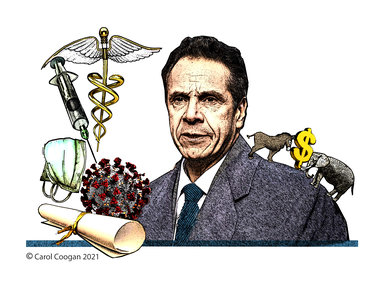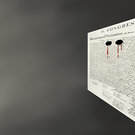Cuomo says “We can’t survive with these economic shutdowns.” What if we can’t survive without them?
On May 1, 2020, Governor Andrew Cuomo announced that all schools and colleges in New York would remain closed for the rest of the academic year and would continue to provide distance learning.
“We must protect our children,” he said.
The decision was widely applauded by teachers’ unions, school boards, and state education leaders.
Nine months later, we’re looking back at that decision to inform where we are now and how we should proceed.
That was in a time when deaths nationwide from the coronavirus disease topped 70,000 and Albany County had 53 deaths. Now, the nation’s death toll from COVID-19 is well over 400,000 and Albany county’s toll is over 300.
Cuomo put it pointedly in his press briefing that week: “The fundamental question which we’re not articulating is: How much is a human life worth?”
New York State set up a system then to let each of the state’s 10 regions reopen when certain metrics were met.
Albany County, like counties across the state, hit an apex of COVID-19 infections and then new infections leveled off.
When outbreaks spiked in certain places, Cuomo adopted a micro-cluster plan to tamp down on those places by instituting zones with restrictions — the most severe being red zones where schools and nonessential businesses would again be shut down.
Then came Cuomo’s winter plan where, he said, the focus would shift to hospital capacity. Albany County long ago surpassed the infection rates that would have brought micro-cluster restrictions but no restrictions have been applied.
All along, Cuomo has said to follow the science — something we’ve wholeheartedly endorsed on this page and still do.
But what does the science tell us?
On May 12, 2020, the World Health Organization advised governments that, before reopening, rates of positivity in COVID-19 testing should remain at 5 percent or lower for at least 14 days.
For months, Cuomo proudly pointed to the Johns Hopkins tracking of states’ positivity rates. That was when New York State was among three states with the lowest rates in the nation, well below the World Health Organization’s threshold.
Cuomo hasn’t pointed to the Johns Hopkins tracking for months. New York State is now above the 5-percent threshold. Ten states are below that threshold as is Guam and the District of Columbia; Vermont is the lowest at 2.24 percent. Albany County is above that threshold, too, and has been for months.
The change in the governor’s approach was abundantly evident in December when he said at a press briefing that he was working on his State of the State Address and would be using a Buffalo Bills playoff game as a model.
“I want to do everything I can to avoid a shutdown,” Cuomo said to reporters. “The shutdown does tremendous economic damage and collateral damage to families. We can’t survive with these economic shutdowns.”
This is a global challenge, he said. “And there will be winners and losers through this period. And that’s the really smart long-term vision that we have to have in this state.”
“Can you reopen venues using rapid testing? Ancillary question: Can you reopen venues using vaccinated people? ...” asked Cuomo. “That’s the question the Department of Health has been analyzing because I want to speak to it in the State of the State,” he said. “But we’re looking to test a hypothesis.”
Spectators were admitted to the Bills’ stadium in Buffalo — filled at less than a tenth of capacity — only if they tested negative for COVID-19.
Albany County Health Commissioner Elizabeth Whalen was asked at a county press conference about the governor’s plan for opening the Bills’ game to fans. It is the only time in 10 months we heard her pass on a question.
That crystallized for us the divergence from science.
In his State of the State Address, Cuomo said, “The truth is we cannot stay closed until everyone is vaccinated. The economic, psychological, and emotional cost would be incredible.”
So, if we return to the governor’s question from May — “How much is a human life worth?” — we see his answer now is it is worth less than economic gain.
If we look at Albany County’s dashboard with a graph charting day-by-day infections, we see the springtime surge, controlled by a shutdown, now looks like an ant hill compared to the mountain of infection we are now ascending — with no restrictions in sight.
In the midst of this surge, we also have the threat of the highly transmissible B.1.1.7 variant of COVID-19, first identified in the United Kingdom, burgeoning in our midst. The Centers for Disease Control and Prevention has said B.1.1.7 could be the dominant variant by March.
Yes, two successful vaccines have been developed but the rollout has been problematic and it will be months — certainly long after March — before enough residents are vaccinated to protect us.
Against this backdrop, college students are returning to Albany County. We understand that colleges and universities have an economic need to have students on campus, paying for room and board as well as classes.
We also understand that, in normal times, they bring much of worth to our community. At last Friday’s county press conference, the president of The College of Saint Rose spoke movingly about being a campus without walls, about how members of the college helped the community.
Albany County Executive Daniel McCoy spoke about how the large state university and smaller colleges in the county help the economy as students support businesses and visiting parents stay in hotels.
What in all other times is a virtue — having academic institutions integral to the community — is a liability in the midst of a surging pandemic.
The science, even as it evolves, is clear.
A CDC study shows how, for the fall semester, in counties where large universities held in-person classes, cases of coronavirus rose by more than 56 percent in the 21 days after classes started compared to the 21 days before.
In similar-sized nearby counties without large colleges or universities, COVD-19 cases decreased by 6 percent during similar timeframes, the study found.
Counties where universities used remote-only instruction had about an 18-percent decline during the 21 days before through the 21 days after the start of classes while counties with in-person classes at their universities, again, saw an increase of over 56 percent in COVID-19 incidence.
Often, college-age students with COVID-19 have few if any symptoms and can unwittingly spread the virus to others in the community, which is difficult if not impossible to trace. The University at Albany had such a large spike of cases in the fall that it ended in-person classes early.
Certainly, we commend local colleges for their strategies to mitigate the spread of the virus, detailed in our story this week, but the bottom line, based on the science, is: Remote-only classes should be held until enough staff and students have been vaccinated for herd immunity.
The science has been less clear on classes for younger students. Cuomo has said repeatedly it is his opinion that children are safer in school. That opinion was borne out on Tuesday when researchers from the CDC said in the Journal of the American Medical Association that “accumulating data now suggest” in-person learning can take place as long as masks are worn and social distancing is observed.
“Actions include taking steps to reduce community transmission” — the authors mention “restrictions on indoor dining at restaurants” — “and limiting school-related activities such as indoor sports practice or competition that could increase transmission risk,” the article says.
We continue to commend our local schools for so assiduously having staff and students follow safety protocols, from social distancing to mask-wearing and hand-washing.
We further commend schools, like Guilderland, that are currently undertaking random surveillance testing of staff and students at school.
Those results will provide the data needed for parents and the community to know how safe the schools really are.
If our leaders make decisions based on science, we’ll all be safer.



Where is the data that show who is extremely effected by this virus? Also I don’t see you data on how kids are handling remote learning, mental health and academics? Lockdowns do not work. The data shows this. The data also show kids and young adults are not adversely effected by this virus. So why would we lockdown a whole population for something that effects only a detain portion of it? We need to stop spreading all this fear on the virus. We need freedom of choice not lockdowns. This piece spreads more fear which is not warranted, but it gets clicks.